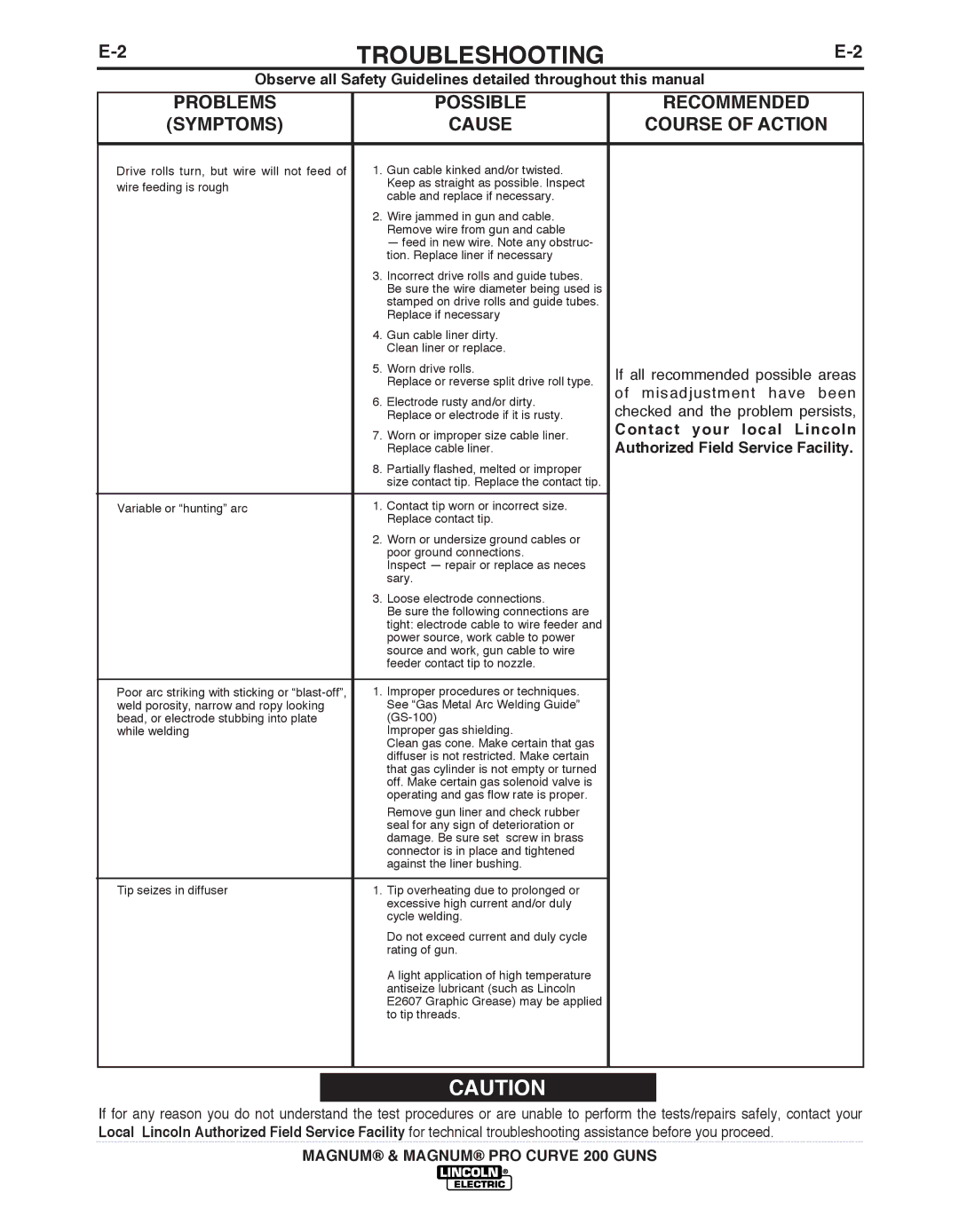
TROUbLESHOOTING | ||
|
|
|
| Observe all Safety Guidelines detailed throughout this manual |
|
|
|
|
PRObLEMS
(SYMPTOMS)
POSSIbLE
CAUSE
RECOMMENDED
COURSE OF ACTION
Drive rolls turn, but wire will not feed of | 1. Gun cable kinked and/or twisted. | |
wire feeding is rough |
| Keep as straight as possible. Inspect |
| cable and replace if necessary. | |
|
| |
| 2. | Wire jammed in gun and cable. |
|
| Remove wire from gun and cable |
|
| — feed in new wire. Note any obstruc- |
|
| tion. Replace liner if necessary |
| 3. | Incorrect drive rolls and guide tubes. |
|
| Be sure the wire diameter being used is |
|
| stamped on drive rolls and guide tubes. |
|
| Replace if necessary |
| 4. | Gun cable liner dirty. |
|
| Clean liner or replace. |
| 5. | Worn drive rolls. |
|
| Replace or reverse split drive roll type. |
| 6. | Electrode rusty and/or dirty. |
|
| Replace or electrode if it is rusty. |
| 7. | Worn or improper size cable liner. |
|
| Replace cable liner. |
| 8. | Partially flashed, melted or improper |
|
| size contact tip. Replace the contact tip. |
|
| |
Variable or “hunting” arc | 1. Contact tip worn or incorrect size. | |
|
| Replace contact tip. |
| 2. Worn or undersize ground cables or | |
|
| poor ground connections. |
|
| Inspect — repair or replace as neces |
|
| sary. |
| 3. Loose electrode connections. | |
|
| Be sure the following connections are |
|
| tight: electrode cable to wire feeder and |
|
| power source, work cable to power |
|
| source and work, gun cable to wire |
|
| feeder contact tip to nozzle. |
|
| |
Poor arc striking with sticking or | 1. Improper procedures or techniques. | |
weld porosity, narrow and ropy looking |
| See “Gas Metal Arc Welding Guide” |
bead, or electrode stubbing into plate |
| |
while welding |
| Improper gas shielding. |
|
| Clean gas cone. Make certain that gas |
|
| diffuser is not restricted. Make certain |
|
| that gas cylinder is not empty or turned |
|
| off. Make certain gas solenoid valve is |
|
| operating and gas flow rate is proper. |
|
| Remove gun liner and check rubber |
|
| seal for any sign of deterioration or |
|
| damage. Be sure set screw in brass |
|
| connector is in place and tightened |
|
| against the liner bushing. |
|
| |
Tip seizes in diffuser | 1. Tip overheating due to prolonged or | |
|
| excessive high current and/or duly |
|
| cycle welding. |
|
| Do not exceed current and duly cycle |
|
| rating of gun. |
|
| A light application of high temperature |
|
| antiseize lubricant (such as Lincoln |
|
| E2607 Graphic Grease) may be applied |
|
| to tip threads. |
|
|
|
If all recommended possible areas of misadjustment have been checked and the problem persists,
Contact your local Lincoln Authorized Field Service Facility.
![]() CAUTION
CAUTION
If for any reason you do not understand the test procedures or are unable to perform the tests/repairs safely, contact your Local Lincoln Authorized Field Service Facility for technical troubleshooting assistance before you proceed.
MAGNUM® & MAGNUM® PRO CURVE 200 GUNS
